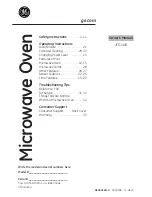
ChefTop™
LineMicro™
5. TURNING OFF IN CASE OF BREAKDOWN
If there is a breakdown, deactivate the appliance:
a- disconnect the electrical power supply automatic circuit
breaker placed upstream from the appliance or, in case of
no circuit breaker, unplug the appliance.
b- consult a technical service centre authorized by the man
facturer where you can find trained personnel.
III. COOKING PRINCIPLE
1. COOKING TYPOLOGIES
The types of cooking you can realize with the appliance
described on this manual are Bread, Pastry professional
baking and Gastronomy professional cooking with CON-
VECTION, that means the baking is realized through hot air.
WARNING:
a- Before any use, heat up the oven setting a cavity tem-
perature 30 °C (54 °F) higher than the desired cooking
temperature.
This allows you to obtain the best baking uniformity.
b- Use of higher temperatures than those needed by the
product causes an uneven baking.
c- Bread and Pastry baking: do not use trays with a height of
more than 20 mm and avoid that the single units on the
tray get in touch.
d- Do not overload the trays.
In convection ovens the cooking is done by hot air that
circulates round and round inside the cooking chamber.
This allows to realize an even cooking, also because in
this way the heat is homogeneously distributed.
An even baking is guaranteed also when the oven is fully
loaded. The food is perfectly baked both on the surface,
with a golden crust, and in the internal part, with a uni-
form structure and a constant residual humidity.
The main advantage is the possibility to cook at the same
time different types of food without mixing their flavours
( as long as the required cooking temperature is the same
for all the cooked products).
2. COOKING VARIABLES
TEMPERATURE
The exact setting of the temperature grants a proper
cooking of the food, both inside and outside.
A lower temperature than the proper one dries the food
rather than cook it.
A higher temperature than the proper one burns the sur-
face while the core of the food remains uncooked (some-
times this is desired, especially with meat dishes).
TIME
This variable depends a lot on the quantity of food put in
the oven. The bigger the quantity of food, the longer the
cooking time and vice versa.
A shorter cooking time than that required by the food
does not allow to have completely cooked food.
A longer cooking time than that required by the food
causes the burning of the food surface.
QUANTITY OF FOOD
The quantity of food affects the cooking time.
The bigger the quantity of food, the longer the cooking
time and vice versa.
An overload of the oven can give, as a result, an uneven
cooking.
3. USE OF TRAYS – WIRE GRIDS
It is recommended the use of:
• Aluminium trays: Pastry, non-frozen bread
• Stainless steel trays: first courses, meat, fish, potatoes
• Wire grids: meat to be finished such as steaks, hot-dogs,
sausages, frozen bread, frozen pizza
IV. MAINTENANCE
1. ORDINARY MAINTENANCE
All maintenance operations must be done only by quali-
fied personnel.
Before starting any maintenance operation, you need to
disconnect the appliance from the electrical power sup-
ply and wait for the appliance to cool down.
The parts that need ordinary maintenance can be reached
removing the front control panel and the back of the oven.
The appliance must be regularly controlled (at least once
a year). A specialized technician has to control the com-
plete machine
2. SPECIAL MAINTENANCE
All maintenance operations must be done only by quali-
fied personnel.
Before starting any maintenance operation, you need to
disconnect the appliance from the electrical power sup-
ply and wait for the appliance to cool down.
The parts that need special maintenance can be reached
removing the front control panel and the back of the oven.
2.1 REPLACEMENT OF INTERNAL LAMP (IF
PRESENT)
5
ENGLISH
Содержание LineMicro XF023
Страница 32: ...LI1920A2 OVENS PLANET www unox com...







































